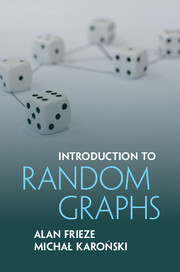14 - Trees
from PART III - Other models
Published online by Cambridge University Press: 05 November 2015
Summary
The properties of various kinds of trees are one of the main objects of study in graph theory mainly due to their wide range of application in various areas of science. Here we concentrate our attention on the “average” properties of two important classes of trees: labeled and recursive. The first class plays an important role in both the sub-critical and super-critical phase of the evolution of random graphs. While random recursive trees serve as an example of the very popular random preferential attachment models. In particular we will point out, an often overlooked fact, that the first demonstration of a power law for the degree distribution in the preferential attachment model was shown in a special class of inhomogeneous random recursive trees.
The families of random trees, whose properties are analyzed in this chapter, fall into two major categories according to the order of their heights: they are either of square root (labeled trees) or logarithmic (recursive trees) height. While most of square-root-trees appear in probability context, most log-trees are encountered in algorithmic applications.
Labeled Trees
Consider the family Tn of all nn−2 labeled trees on vertex set [n] = {1, 2, …,n}. Let us choose a tree Tn uniformly at random from the family Tn. The tree Tn is called a random tree (random Cayley tree).
The Prüfer code [638] establishes a bijection between labeled trees on vertex set [n] and the set of sequences [n]n−2 of length n−2 with items in [n]. Such a coding also implies that there is a one-to-one correspondence between the number of labeled trees on n vertices with a given degree sequence d1,d2, …,dn and the number of ways in which one can distribute n−2 particles into n cells, such that the ith cell contains exactly di − 1 particles.
Information
- Type
- Chapter
- Information
- Introduction to Random Graphs , pp. 263 - 293Publisher: Cambridge University PressPrint publication year: 2015
